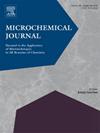Gold nanoclusters and amino-modified mesoporous silica-encapsulated carbon dot fluorescence nanosensors combined with LightGBM algorithm for ultra-fast detection of Co2+
IF 4.9
2区 化学
Q1 CHEMISTRY, ANALYTICAL
引用次数: 0
Abstract
In this study, we develop a novel ratiometric fluorescent nanosensor for the detection excess Co in soil. This fluorescent nanosensor is fabricated using mesoporous silica-encapsulated nitrogen-doped carbon dots (N-CDs@mSiO) and gold nanoclusters stabilized by bovine serum albumin (BSA-AuNCs). The green fluorescence of the carbon dots within the mesoporous silica spheres (mSiO) serves as an internal reference signal. The red fluoresence BSA-AuNCs are covalently connected onto the surface of amino-functionalized nanospheres (N-CDs@mSiO-NH), providing the response signal. This nanosensor has dual emission peaks at 520 nm and 650 nm under excitation wavelength of 380 nm. The addition of Co to this nanosensor causes the fluorescence quenching at 650 nm while the green fluorescence at 520 nm remains unchanged, resulting in fluorescence color change from yellow to green. The developed ratiometric fluorescence nanosensor exhibits excellent selectivity to Co with a range of 2.00–200.00 μM and a detection limit as low as 0.74 μM. In addition, a Co prediction model is developed using the Light Gradient Boosting Machine (LightGBM) algorithm. The entire detection process is within 10 s and the model prediction value is as high as 0.991 on average. This shows that the proposed fluorescent nanosensor, optimized with the LightGBM algorithm, provides an efficient, environmentally friendly and potentially practical solution for Co detection.金纳米团簇和氨基修饰介孔二氧化硅封装碳点荧光纳米传感器与 LightGBM 算法相结合,用于超快速检测 Co2+
在本研究中,我们开发了一种新型比率荧光纳米传感器,用于检测土壤中过量的钴。这种荧光纳米传感器是利用介孔二氧化硅封装的掺氮碳点(N-CDs@mSiO)和牛血清白蛋白稳定的金纳米团簇(BSA-AuNCs)制成的。介孔二氧化硅球(mSiO)中碳点的绿色荧光可作为内部参考信号。红色荧光 BSA-AuNCs 与氨基功能化纳米球(N-CDs@mSiO-NH)表面共价连接,提供响应信号。在 380 nm 的激发波长下,该纳米传感器在 520 nm 和 650 nm 处具有双发射峰。向该纳米传感器中添加 Co 会导致 650 nm 处的荧光淬灭,而 520 nm 处的绿色荧光保持不变,从而使荧光颜色从黄色变为绿色。所开发的比率荧光纳米传感器对 Co 具有极佳的选择性,其选择范围为 2.00-200.00 μM,检测限低至 0.74 μM。此外,还利用光梯度提升机(LightGBM)算法建立了一个 Co 预测模型。整个检测过程在 10 秒内完成,模型预测值平均高达 0.991。这表明,利用 LightGBM 算法优化的拟议荧光纳米传感器为 Co 检测提供了一种高效、环保且具有潜在实用性的解决方案。
本文章由计算机程序翻译,如有差异,请以英文原文为准。
求助全文
约1分钟内获得全文
求助全文
来源期刊

Microchemical Journal
化学-分析化学
CiteScore
8.70
自引率
8.30%
发文量
1131
审稿时长
1.9 months
期刊介绍:
The Microchemical Journal is a peer reviewed journal devoted to all aspects and phases of analytical chemistry and chemical analysis. The Microchemical Journal publishes articles which are at the forefront of modern analytical chemistry and cover innovations in the techniques to the finest possible limits. This includes fundamental aspects, instrumentation, new developments, innovative and novel methods and applications including environmental and clinical field.
Traditional classical analytical methods such as spectrophotometry and titrimetry as well as established instrumentation methods such as flame and graphite furnace atomic absorption spectrometry, gas chromatography, and modified glassy or carbon electrode electrochemical methods will be considered, provided they show significant improvements and novelty compared to the established methods.
文献相关原料
| 公司名称 | 产品信息 | 采购帮参考价格 |
|---|
 求助内容:
求助内容: 应助结果提醒方式:
应助结果提醒方式:


